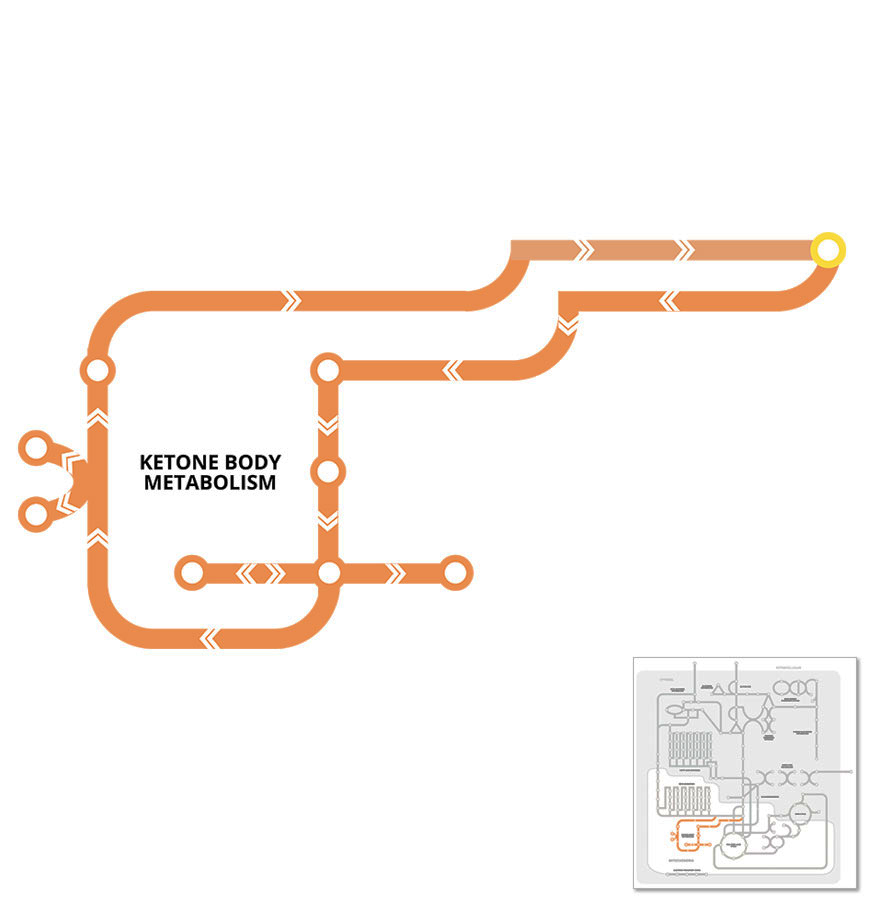
highlight all areas / label key areas

Ketones or ketone bodies, which include acetone, acetoacetate and β-hydroxybutyrate, are produced by the liver when the process of beta-oxidation (see Beta-Oxidation pathway) is elevated, such as during extended fasting or starvation, consumption of low carbohydrate diets, during prolonged exercise and in uncontrolled type 1 diabetes.
Ketones are released by the liver and are taken up by tissues such as the brain, heart and skeletal muscle, where they can be oxidised to produce ATP. Oxidation of ketones reduces the reliance on glucose under conditions of low carbohydrate availability, such as the situations described above.
Key points:
Ketones are produced from acetyl-CoA. In states where the process of beta-oxidation (see Beta-Oxidation pathway) is elevated such as during starvation and excessive exercise, the acetyl-CoA produced from the oxidation of fatty acids exceeds the energetic needs of the liver. This excess acetyl-CoA spills over into ketone body production (ketogenesis), with the first step converting acetyl-CoA to acetoacetyl-CoA.
Around 95% of the acetyl-CoA used for ketogenesis is derived from fatty acids. Amino acids contribute around 4%, while glucose only contributes around 1%. Although glucose can form acetyl-CoA from pyruvate, the end-product of glycolysis (see Glycolysis pathway), pyruvate does not readily form acetyl-CoA under conditions of low carbohydrate availability. Instead, it contributes to the citric acid cycle intermediates by forming oxaloacetate through the actions of pyruvate carboxylase (see The Citric Acid Cycle pathway). This ensures adequate flow of metabolites into the citric acid cycle, which provides high levels of oxaloacetate for gluconeogenesis (see Gluconeogenesis pathway) when glucose availability is low.
Key point:
In the oxidation of ketone bodies in peripheral tissues, succinyl-CoA is an important donor of CoA in the conversion of acetoacetate to acetoacetyl-CoA:
Acetoacetate + Succinyl-CoA → Acetoacetyl-CoA + Succinate
In ketogenesis, 3 hydroxy butyric acid (β-hydroxybutyrate) is synthesised from acetoacetate by β-hydroxybutyrate dehydrogenase (BDH1):
Acetoacetate + NADH + H+ → β-hydroxybutyrate + NAD+
It is released into the circulation and is taken up by other tissues by monocarboxylate transporters, before being converted back to acetoacetate and ultimately to acetyl-CoA, where it can enter the citric acid cycle (see The Citric Acid Cycle pathway) for further oxidation.
Acetoacetate is produced in the mitochondria from hydroxy-β-methylglutaryl-CoA by the enzyme HMG-CoA lyase:
Hydroxy-β-methylglutaryl-CoA → Acetoacetate + Acetyl-CoA
It is exported from the mitochondria and across the plasma membrane by members of the monocarboxylate transporter family.
It is taken up in target tissues through similar mechanisms, before being converted back to acetoacetyl-CoA through the actions of succinly-CoA:3-oxoacid-CoA transferase (SCOT):
Acetoacetate + Succinyl-CoA → Acetoacetyl-CoA + Succinate
SCOT is the rate limiting enzyme in ketone oxidation and is inhibited primarily by fatty acids.
Although a ketone body, acetone is a decarboxylated form of acetoacetate, which cannot be converted back to Acetyl-CoA. It has currently no known physiological role and is exhaled through the lungs.
Acetone imparts a particular smell when exhaled that is particularly noticeable in patients with uncontrolled type 1 diabetes.
HMG-CoA synthase is the rate limiting enzyme for ketogenesis and converts acetoacetyl-CoA into hydroxy-β-methylglutaryl-CoA:
Acetoacetyl-CoA + Acetyl-CoA + H2O → Hydroxy-β-methylglutaryl-CoA + CoA
The mitochondria form of the enzyme participates in ketogenesis, while a cytosolic form is involved in the mevalonate pathway.
It is activated by glucagon and inhibited by insulin.